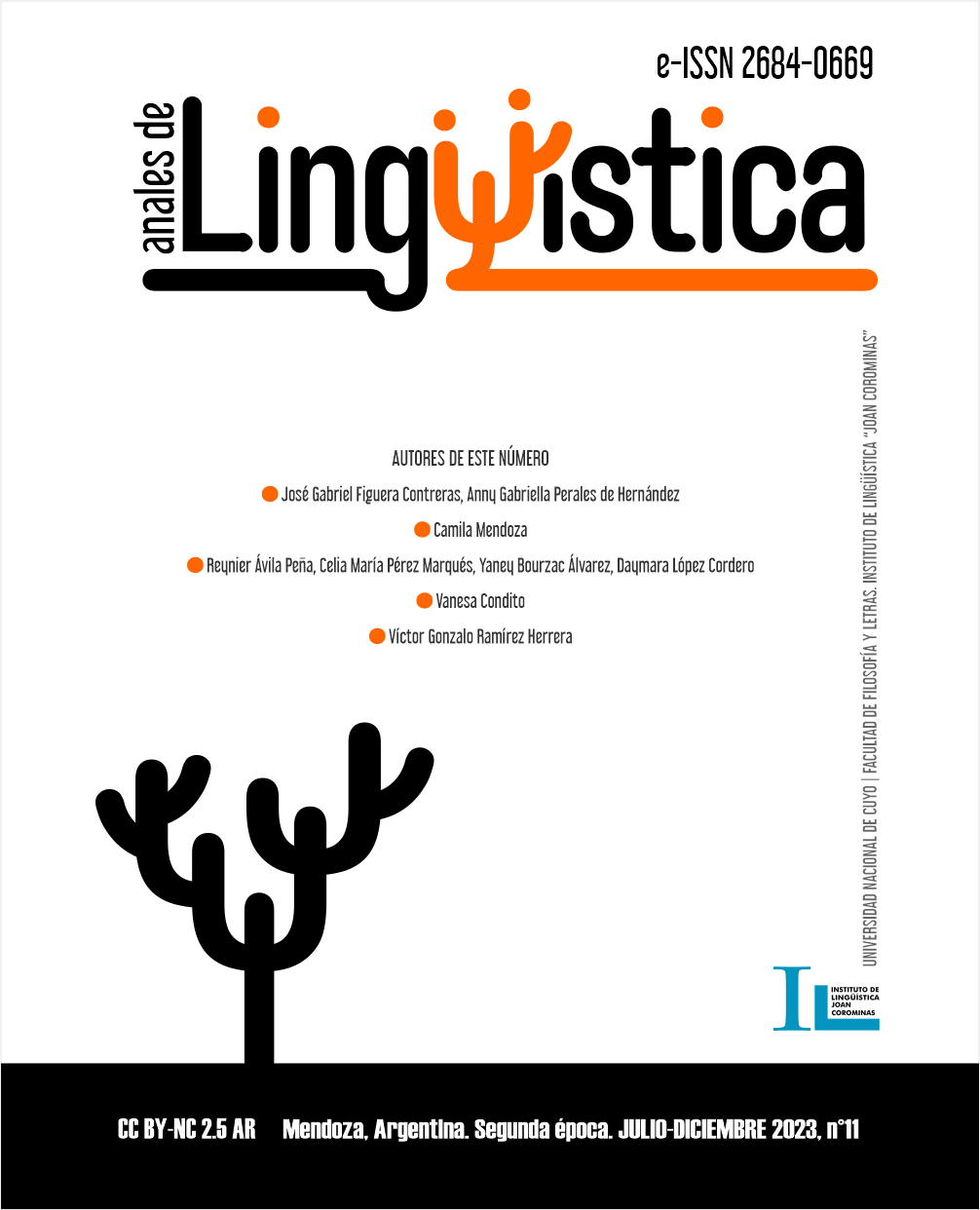Sobre las vocales largas en los préstamos del castellano al quechua huanca
Palabras clave:
Fonología, Fonética, quechua I, percepción categorialResumen
Esta investigación estudia el comportamiento de algunos elementos léxicos del castellano al momento de ser adaptados al sistema fonológico del quechua huanca. Por un lado, esta variedad pertenece al Quechua I y presenta la distinción significativa entre vocales largas y vocales breves (Adelaar, 1984; Cerrón-Palomino, 1987, p. 254; Parker, 1963, p. 247; Torero, 1964, p. 30) y, además, es funcional y productiva en la actualidad (Cerrón-Palomino, 1976a, pp. 34-36; 1987c, pp. 234-235; Julca, 2021, pp. 32-42). Por otro lado, el castellano no presenta dicho rasgo; no obstante, al momento de prestar términos al quechua, dicha distinción surge en los elementos nativizados. La hipótesis de trabajo que aquí concierne indica que existe un proceso de decisión categorial (Escudero, 2005, pp. 7-13) sobre el input castellano desde los criterios fonéticos y fonológicos del quechua huanca. Es decir, el oído huanca decide desde los criterios de su lengua si la duración alofónica de las vocales del castellano se adaptan como vocales largas o cortas. Aquí se analizarán ambos sistemas para comprender el proceso de adaptación implicado. Para defender esta postura, seguiremos tres pasos: en primer lugar, presentaremos el problema con ejemplos. En segundo lugar, plantearemos nuestra solución y los pasos para demostrarla. En tercer lugar, recogeremos lo descrito y propondremos algunas predicciones desde lo encontrado. Finalmente, presentaremos las conclusiones alcanzadas. Nuestra presentación de cada uno de estos puntos será relativamente escueta, pero ilustrativa, por motivos principalmente de espacio.
Citas
Adelaar, W. F. H. (1984). Grammatical Vowel Length and the Classification of Quechua Dialects. International Journal of American Linguistics, 50, 1, 25-47.
Cerrón-Palomino, R. (1967). “Fonología del Wanka”. En: A. Escobar (ed.), Cuatro fonologías quechuas (pp. 55-80), Plan de Fomento Lingüístico - UNMSM.
Cerrón-Palomino, R. (1975). Hispanismos en el quechua wanka. CILA, UNMSM. Documento de Trabajo N° 15.
Cerrón-Palomino, R. (1976a). Gramática Quechua: Junín-Huanca. Ministerio de Educación - Instituto de Estudios Peruanos.
Cerrón-Palomino, R. (1976b). Diccionario Quechua: Junín-Huanca. Ministerio de Educación - Instituto de Estudios Peruanos.
Cerrón-Palomino, R. (1987). Lingüística Quechua. Centro de Estudios Regionales Bartolomé de las Casas.
Cerrón-Palomino, R. (2003). Castellano andino. Aspectos sociolingüísticos, pedagógicos y gramaticales. Fondo Editorial de la Pontificia Universidad Católica del Perú.
Escudero, P. (2005). Linguistic perception and second language acquisition. Explaining the attainment of optimal phonological categorization. Universiteit Utrecht.
Harris, J. (1983). Syllabe Structure and Stress in Spanish: A Nonlinear Analysis. The Mit Press.
Hume, E. y Johnson, K. (2001). The Role of Speech Perception in Phonology. Academic Press.
Julca, Y. (2021) El proceso de alargamiento vocálico en los préstamos del español al quechua de Huánuco. Pontificia Universidad Católica del Perú. Tesis de Maestría. URL: https://tesis.pucp.edu.pe/repositorio//handle/20.500.12404/19891
Muysken, P. y Apel, R. (1996). Bilinguismo y contacto de lenguas. Ariel.
Martínez Celdrán, E. (1994). Fonética (con especial referencia a la lengua castellana), 4° edición. Teide.
Martínez Gil, F. y Colina, S. (ed.) (2006). Optimality-Theoretic Studies in Spanish Phonology. John Benjamins Publishing Co.
Navarro Tomás, T. (1967). Manual de pronunciación española, 13° edición. Instituto Miguel de Cervantes.
Parker, G. (1963). La clasificación genética de los dialectos quechuas. Revista del Museo Nacional, 32, pp.241-252. Lima.
Perlmutter, D. (1996). Phonology Quantity and Multiple Association. En: J. Goldsmith (ed.), The Handbook of Phonology Theory (pp 307-317), Blackwell Publishing.
Prince, A. y Smolensky, P. (1993). Optimality Theory: Constraint Interaction in Generative Grammar. Technical Report #2 of Rutgers Center of Cognitive Science. Rutgers University.
Ramírez Herrera, G. (2014). Vocales largas en los préstamos del castellano al quechua huanca: Un acercamiento descriptivo y explicativo del fenómeno. Pontificia Universidad Católica del Perú. Tesis de Licenciatura.
Rodríguez Mondoñedo, M. (2009). Rima ramificante en sílabas iniciadas con consonante palatal. Mester, 31, 68-85.
Tesar, B; Grimshaw, J. y Prince, A. (2003). “Explicación lingüística y cognitiva de la teoría de la optimalidad”. En: E. Lepere y Z. Pylshyn (eds.), ¿Qué es la ciencia cognitiva? (pp. 346-383), Oxford University Press.
Torero, A. (1964). Los dialectos quechuas. Anales Científicos de la Universidad Agraria, 2, 446-476.
Descargas
Publicado
Cómo citar
Número
Sección
Licencia
Derechos de autor 2023 Víctor Gonzalo Ramírez Herrera
Esta obra está bajo una Licencia Creative Commons Atribución 2.5 Argentina.
Los/as autores/as que publican en esta revista están de acuerdo con los siguientes términos:
1. Los/as autores conservan los derechos de autor y garantizan a la revista el derecho de ser la primera publicación del trabajo bajo una licecncia Creative Commons Atribución 2.5 Argentina (CC BY 2.5 AR) . Por esto pueden compartir el trabajo con la referencia explícita de la publicación original en esta revista.
2. Anales de lingüística permite y anima a los autores a difundir la publicación realizada electrónicamente, a través de su enlace y/o de la versión postprint del archivo descargado de forma independiente.
3. Usted es libre de:
Compartir — copiar y redistribuir el material en cualquier medio o formato
Adaptar — remezclar, transformar y construir a partir del material para cualquier propósito, incluso comercialmente.























